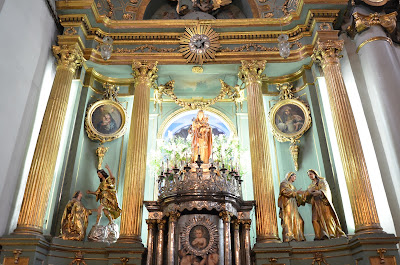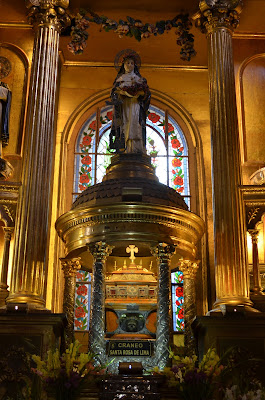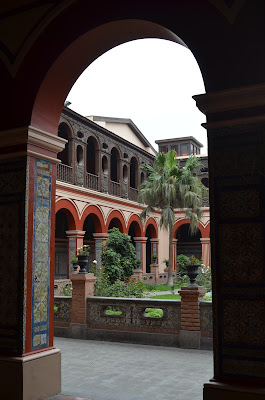From the City of Kings: Baroque Architecture in Peru
NLM Guest Article by Juan J. Alayo, AIA
During a recent brief visit to Peru, I had a chance to visit several churches located in the historic center of the capital, Lima and the northern city of Trujillo. For those who may not be familiar with Peruvian colonial architecture, it is important to note that after the conquest of the Inca empire by Francisco Pizarro, the Viceroyalty of Peru established Spain’s dominance in the cultural, spiritual and economic lives of the inhabitants of the former Empire of the Sun, and became the most powerful and wealthy colony in the New World. As new cities were founded, the Catholic Church and in particular the religious orders, manifest themselves in the most prominent locations adjacent to civic and cultural institutions. Like most Spanish colonial cities, Lima and Trujillo were laid out on a “castrum” plan according to the planning rules of the Law of the Indies and also influenced by the then recently re-discovered writings of Vitruvius, that guided the locations of public buildings as well as religious and private buildings as well as the planning of cities vis-a-vis natural topographic and environmental conditions.After the founding of Lima on January 18, 1535, Pizarro himself allocated the city parcels for the religious orders, individuals, and the governing authority. The Basilica and Convent of San Francisco for the Order of Friars Minor, and the Basilica and Convent of Santo Domingo for the Order of Preachers were located to the north and south of Pizarro’s house which was located in front of the Plaza Mayor and today is the Government Palace. Around the same period, private property was donated for the establishment of the Basilica and Convent of Nuestra Senora de la Merced for the Order of the Blessed Virgin Mary of Mercy (Mercedarians). These three orders are among the most influential religious orders in the history of Peru and have left the national patrimony with three shining examples that preserve the beauty of colonial baroque architecture.
The Basilica and Convent of Santo Domingo
The Basilica and Convent of Santo Domingo was begun in 1534 by Fray Tomas de San Martin and completed under Fray Sebastian de Ayllon in 1578 and is best known for being the home and now burial place of Saint Martin de Porres. The convent’s crypt also houses the remains of Saint Rose of Lima, thus the convent is of national importance being the resting place of the two Peruvian saints. A visit to the convent will allow a visitor to walk the corridors and courtyards that Saint Martin de Porres walked daily, and also visit the unique places in the convent where Saint Martin de Porres carried out his work, performed miracles, and experienced ecstasies while in prayer. The oldest university in the western hemisphere, the Universidad de San Marcos, was chartered here in 1551 in the capitular hall of the convent.
Several styles are prominent in this basilica, resulting from several reconstructions after the earthquakes of 1687 and 1746. What we see today in most of Lima’s colonial monuments are reconstructions after the earthquake of 1687 that leveled 90% of the city. Therefore we see a combination of Rococo and Churriguresque styles within a Baroque building shell with neoclassical interior decorations. The Basilica is built entirely of adobe bricks, and “quincha” which is a local innovation used in the vaulted surfaces made of straw mesh, a mortar mix made of clay, water and egg whites, which gave structures a ductility that to this day performs well under seismic movements. The main altar is in a neoclassical style adorned with gilded columns and paneling. Depicted above the central crucifix is a statue of Saint Dominic with the Blessed Mother and the Infant Jesus, carried aloft by cherubim. Statues of Saint Thomas Aquinas and Saint Dominic frame the sanctuary underneath the dome. To each side of the dome are two elaborate neoclassical style altars: one dedicated to Our Lady of the Holy Rosary, the titular of the Basilica framed by two beautifully sculpted scenes, one of the Annunciation, the other of the Visitation. The statue of Our Lady is thought to be the first to arrive in Lima, a gift from King Charles I. This image is known to have been a place of special veneration by Saint Rose of Lima and Saint Martin de Porres. To the right of the sanctuary is the altar dedicated to the Peruvian saints. Also in neoclassical style, but fully gilded, the altar contains the skull relics of both Saint Rose of Lima and Saint Martin De Porres. The pulpit, which unfortunately is seldom used now, dates from the reconstruction after the earthquake of 1746. The Convent also has a witnessed several reconstructions however the main courtyard remains original from the post 1746 reconstruction and displays a unique design of a wood over masonry arcade in the rococo style. The elaborate wood upper level is punctured at the columns turning it more into a light screen. The lower section is solid and adorned with Sevillian tiles, typical of the era, and adding an arabesque motif to the cloister.
The Basilica and Convent of San Francisco
The Franciscan order’s titular church was founded by the Franciscan Order of the Twelve Apostles by Fray Francisco de la Cruz and first erected in 1546. On February 4, 1655 an earthquake levels the early temple and subsequently the prior Fray Francisco de Borja hired the Portugese architect Constantino de Vasconcellos to design and direct the construction of the new basilica. The cornerstone was laid on the 8th of May 1657 by the Viceroy Luis Enriquez de Guzman, Count of Alba de Liste and the church was inaugurated on October 3rd 1672. Work inside the convent continued through 1729. The interior of the courtyard also is decorated with Sevillian tiles and according to tradition they were installed by Alonso Godinez from Guadalajara, Spain. An interesting story surrounds Godinez who had been condemned to death by hanging for the murder of his wife, and while giving his final confession, he told the confessor of his trade as a tilesetter. Upon knowing this, the confessor immediately went to the Viceroy’s palace to seek his pardon and was able to obtain it on the condition that he wear the Franciscan habit and never leave the convent. The wood for the church was sold by Pedro Jimenez Menacho, who shipped the wood from Nicaragua. It is said that the Friars presented Jimenez with a small vessel of a rare ingredient as payment: chocolate. Upon tasting it, he canceled all the debts owed by the Friars for the material in exchange for the vessel of chocolate.
The façade is a strong Spanish Baroque style and in the images one can see uniqueness with its crenulations across the front and the towers. The stone central façade is carved of grey and brown granite. This granite is likely to have been partially assembled from ballast from ships that arrived empty in Peru, but left loaded with minerals and agricultural goods. The center of the façade is adorned with a statue of the Immaculate Conception over a broken arch supported by composite Baroque columns. One can also see heavy massing of the Basilica which is a result of being located in one of the most seismically active locations in the world. This is a specific feature of many Peruvian colonial churches that differentiate them from their European references. Underneath the church and convent are also Lima’s most extensive catacombs, deep beneath the street level which was the original resting place for the Friars and also many colonial inhabitants of the city. They are so extensive that they interconnect with the church of Santo Domingo, Government Palace and the Cathedral’s networks of catacombs. Only a portion of these are available for visiting today, but are worth the experience.
The Basilica and Convent of Nuestra Senora de la Merced
The history of the Basilica and Convent of Nuestra Senora de la Merced goes back to the founding of Lima, and the donation of the land for the convent on April 13, 1534 by Captain Francisco de Becerra. While Pizarro and his men were still conquering the Andean cities of Cuzco and Jauja, the Mercedarians arrived in Lima, a year before its founding. The first temple was erected in 1591. One of the order’s most important figures in Peru was Fray Pedro Urraca, who came from Spain in 1583 at the age of 19. It is said that during his voyage, the ship he sailed was caught in a hurricane and was almost shipwrecked. Pedro Urraca offered his life to the Blessed Mother should they be saved. Quickly the seas calmed and he continued his voyage to Quito where he began his novitiate. From here he was sent to Peru. Living a life of serious mortifications and penances, he was said to have had a series of conversations with the crucified Christ at the altar of the Santo Cristo de Auxilio. He returned to Spain after many years to become the spiritual director of Queen Isabel de Borbon. He eventually returned to Peru and died on August 7, 1657 at the age of 74 and is buried at the foot of the altar. He was declared Venerable by Pope John Paul II in 1981.
The current Basilica dates to a restoration in 1746 after the earthquake of the same year. The elaborate frontispiece is adorned with solomonic columns and a sculpture of Our Lady with San Pedro Nolasco. The carvings are made from a combination of grey local granite and Panamanian pink granite brought aboard ships as ballast; one can see the modular size of the ballast blocks in contrast to the larger grey granite pieces. It is the only façade in Lima with this unique color combination and composition.
On the interior, the main altar is gilded entirely and focuses on the main image of our Lady of Mercy (in the photos, the statue had been relocated to the side as this was taken during the month of solemn processions and feasts). Adjacent in the side transept is the recently restored altar dedicated to the Sacred Heart of Jesus and the Peruvian Saints. Other altars of note are those dedicated to The Dolorosa, San Serapion, and San Ramon Nonato, from the Mercedarian order. One can see the difference in artistic styles in each: Neoclassical, Baroque, and Churriguresque. But also of interest is the artists’ different use of sculpture, painting, and decoration in unique compositions creating a visually compelling altarpiece.
The Cathedral of Trujillo
The city of Trujillo is located about an hour’s flight north of Lima and was founded by Pizarro in honor of his birthplace in Spain. The Cathedral was first built between 1647 and 1666 facing the Plaza de Armas in the center of the city. What is interesting to observe here in light of the previous discussions about earthquakes, are the relatively massive forms of the Cathedral-the heavy bell towers, small and minimal openings, and the solid corner conditions of the base. These forms are a response to the need for resisting the frequent earthquakes that have plagued the coast of Peru for millennia. The ornamentation also follows the clues from the building mass by contrasting strong horizontal and large scaled cornices with wide solid engaged columns and pilasters. The center frontispiece is a baroque design with a broken pediment and centered by a stained glass window. In contrast to the other churches in the Lima, the Cathedral is of “one material” and its ornamentations are articulated by changes in paint color instead of material changes or applications.
Palacio Arzobispal de Lima
The Palacio Arzobispal is currently used as the Museo Arzobispal connected to the Cathedral of Lima. Archbishop Juan Luis Cardenal Cipriani Thorne recently renovated and re-opened the palace as a museum of historical and religious art. The site has been the location of the Archbishop of Lima’s residence since the founding of Lima however the current building actually dates from 1924 designed by Polish architect Ricardo de Jaxa Malachoski, and engineered by Peruvians Claude Sahut, and Enrique Mogrovejo. This is an example of what is known locally as Neocolonial style with Neobaroque elements. The wood balconies are hand carved of cedar and reflect both the Andalucian screened balconies prevalent in historic Lima, as well as refer back to the original origins in Andalucia. The central portal is considred a Neoplateresco style and is made of re-integrated stone composite material. The design makes a direct reference to the Viceroy’s Palacio de Torre Tagle which is considered to be the best example of civil colonial architecture in Lima.
Considerations
The images from these buildings are only a selection and cannot possibly catalog the richness of craftsmanship, technology, and beauty that each building conveys to the observer or the faithful who visit them for worship or just aesthetic appreciation. It is also just a sample of the many religious monuments that are present in Peru. What I found on this trip however was vocalized best by a friend who upon seeing these images observed “What marvelous work. And so advanced beyond what we had in North America in the same period”. I had never thought about this comparison before, but it makes one think even more about how the evangelization of the Americas left such an important legacy to the world of art and architecture, a legacy that is inviting those who may not have been aware of the developments here in the Americas during the 16th and 17th centuries to further study and consider these artistic treasures.



